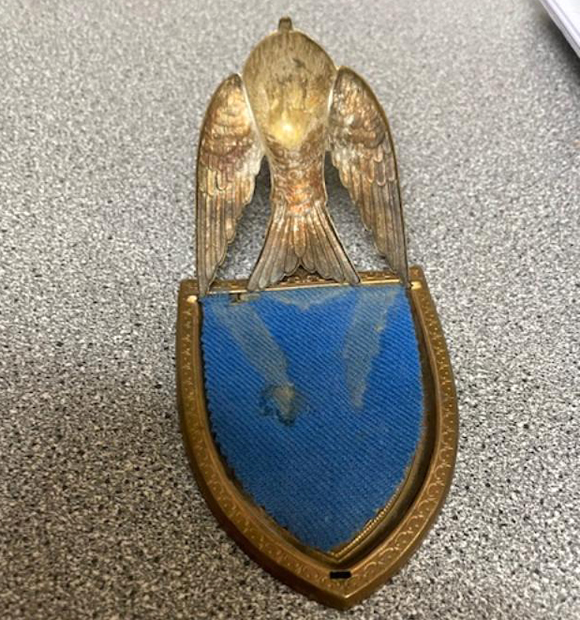Shield with Bird

Needle Case

Design Representation

With interior fabric (photo courtesy of Robert Bleasdale of Bleasdales Ltd., Warwick, UK)
Design Details
Needle Case Type: |
Figural |
Patent/Registered to: |
W. Avery & Son - Redditch |
Patent/Design Representation #: |
Ornamental Class1: Metal: #275518 |
Patent/Design Registration Date: |
August 25, 1873 |
Location of Patent/Design Registration: |
The National Archives (TNA) - Kew, UK |
Reference #: |
TNA Representation - BT 43/34/275518
TNA Register - BT 44/3/275518 |
Dimensions: |
6.6 x 3 x 9.2 |
Material: |
Brass with fabric insert. Be advised that a number of the Shield style needle cases have been found with a small piece of thick fabric on the
inside where individual needles or pins could be inserted. Many of these appear to be original as the fabrics are very similar. Other examples can be found
on the Shield with Ladies Portrait Bust and the Shield with Stag Head web pages. A special thank you goes to Robert Bleasdale of Bleadales Ltd. auctions in Warwick, UK for
bringing this to our attention and sharing a photo of the Shield with Bird with the interior fabric. |
Name Variations: |
W. Avery & Son - Redditch |
Other Variations: |
a) Shield with Ladies Portrait Bust
b) Shield with Rose
c) Shield with Stag Head |
Additional Photographs


Front and side views


Interior and back views


Interior detail and signature detail
Facts
Today there are approximately ten million different bird species in the world and each has distinct characteristics that sets it apart
from the others. Many birds are migratory by nature and travel from one area to another depending upon the season of the year and
climate. Pigeons and doves belong to the same bird family with about 310 species distributed throughout the world. They are highly
adaptable so species can be found in almost all habitats on the planet. They tend to have short bills and legs, and small heads on large
compact bodies.

History
Keeping “fancy pigeons” was a popular hobby in Victorian England. It was relatively inexpensive so could be enjoyed by even the
working classes. Queen Victoria was an enthusiast and was said to have a particular liking for the Jacobin variety. In 1855 Charles
Darwin kept and studied some of these “fancy” varieties to test his theories of animal specialisation, their general popularity making many
breeds readily available. At first he expressed no great enthusiasm for working with pigeons, but with time he professed to deriving
great amusement from his birds and increased the number of varieties in his pigeon loft. The pigeon studies were used to document the
analogy of artificial selection in The Origin of Species.

English Pouter
Miscellaneous
Victorian Recipe from 'The Dictionary of Daily Wants' - 1859
PIGEON PIE. - Rub the pigeons with pepper and salt inside and out; put in a bit of butter, and, if approved, some parsley chopped with the
livers, and a little of the same seasoning. Lay a beefsteak at the bottom of a dish, and the birds on it; between every two a hard
egg. Put a cupful of water in the dish; and if a thin slice or two of ham be added, it will greatly improve the flavour. When ham
is cut for gravy or pies, the under part should be taken rather than the prime. Season the gizzards and two joints of the wings, and
place them in the centre of the pie. Over them, in a hole made in the crust, insert the feet nicely cleaned, and leave them protruding-,
to indicate the contents of the pie.

Note: Right side panel text and pictures provided by Lynda Herrod.
















